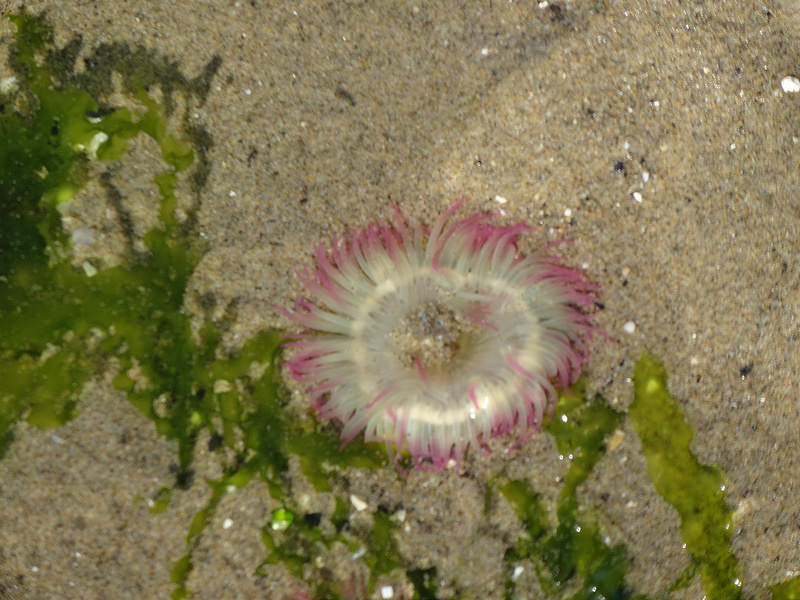Washington offered much, but it was time to say goodbye and bag our first new state in weeks.
The area around Astoria, Oregon, would be our home for five days. How could you not visit a town with such a soothing name as “Astoria?” Plus, Astoria is home to the “Goondocks,” a neighborhood that provided the setting for the hit 1980s movie The Goonies. Or, for those more interested in real history, Astoria lies at the mouth of the Columbia River near where the Corps of Discovery first laid eyes on the Pacific Ocean.
We first stayed at Fort Stevens State Park in the far northwestern corner of Oregon. In true Goonies tradition, visiting a shipwreck was our first order of business. The Peter Iredale ran aground in 1906 approaching the mouth of the Columbia River. It has been there ever since, rotting in the Graveyard of the Pacific constantly battered by salty sea air and ocean waves. Low tide afforded a picture in what remains of the bow.
Bike trails made travel throughout the park easy and fun.
Fort Stevens holds the distinction of being the only continental U.S. military installation attacked by the Axis Powers in WWII. We rode out to Battery Russell, the target of bombardment from a Japanese submarine in 1942.
Peaceful solitude marked a day at the beach under overcast skies. The younger crowd braved the chilly waters. And constructed a “Labyrinth of Protection.”
And constructed a “Labyrinth of Protection.”


Back at the campsite, we all enjoyed hanging out.
After a couple of days at Fort Stevens, we moved to Lewis & Clark RV Park, just south of Astoria and close to the Lewis and Clark National Historical Park. The park showcases an authentic recreation of Fort Clatsop, the winter encampment for the Corps of Discovery from December 1805 to March 1806.
We arrived at opening and Michael was asked to once again put his scout skills to good use, raising the 15-star and 15-bar flag that flew over Ft. Clatsop.
Incidentally, this was the same style of flag that flew over Ft. McHenry during the War of 1812 when Francis Scott Key composed “Defence of Fort M’Henry,” now better known as The Star Spangled Banner.
A local history teacher in period costume, provided a rousing account of the adventures of the Corps of Discovery and demonstrated weaponry.
Fulfilling their mission as dictated by Thomas Jefferson, Lewis & Clark wrote millions of words describing their journey, Indian encounters, and the terrain, animals, and plants observed, among many other things. The kids took a crack at drafting a few words using period-authentic instruments (i.e. quills).
The kids earned Junior Ranger Badge #17 and all had a good day at Fort Clatsop.
The Corps of Discovery setup a Salt Works on the beach to produce enough salt to cure meats for their return journey. Just south of the Salt Works, iconic Haystack Rock rises from the ocean. A stroll down Cannon Beach brought us to the inter-tidal area around Haystack Rock.
A stroll down Cannon Beach brought us to the inter-tidal area around Haystack Rock.

Ochre sea stars clung to the rocks.
Giant green sea anemones filled the tidal pools.
A few aggregate anemones joined them. A black leather chiton sunned himself along purple and orange ochre sea stars.
A black leather chiton sunned himself along purple and orange ochre sea stars.
 Pockets of life existed around every corner.
Pockets of life existed around every corner.

Fueled by crepes consumed in downtown Cannon Beach and the desire to obtain more park service hardware and patches, the kids pressed to tour the Lewis and Clark sites along the Washington shore of the Columbia River. En route to Cape Disappointment State Park, we passed through the “Dismal Nitch,” where fierce November weather stranded the Corps for six days, and Station Camp, where the Corps voted to cross to the southern shore of the Columbia River to set up winter camp at what would become Fort Clatsop.
Cape Disappointment overlooks the Pacific at the mouth of the Columbia River and marks the westernmost point of the Corps journey. The Interpretive Center on site has a large collection of exhibits and hands-on activities that bring the journey of the Corps, and the history of the Cape, to life.
A tour of the North Head Lighthouse capped the afternoon.
 Throughout our adventures in the area, Astoria provided great waterfront dining.
Throughout our adventures in the area, Astoria provided great waterfront dining.
What about the Goonies house? Well, it sits up a hill at the end of a dead-end street and drive-by viewing is discouraged. A walk up the hill when we were in the area was not in the cards. Now the owner has enshrouded the house in blue tarp to discourage visitors (seriously, you can google it). I’m not sure that will work because “Goonies never say die.”






So pretty – I love Haystack Rock. Well that and Baby Ruths of course.